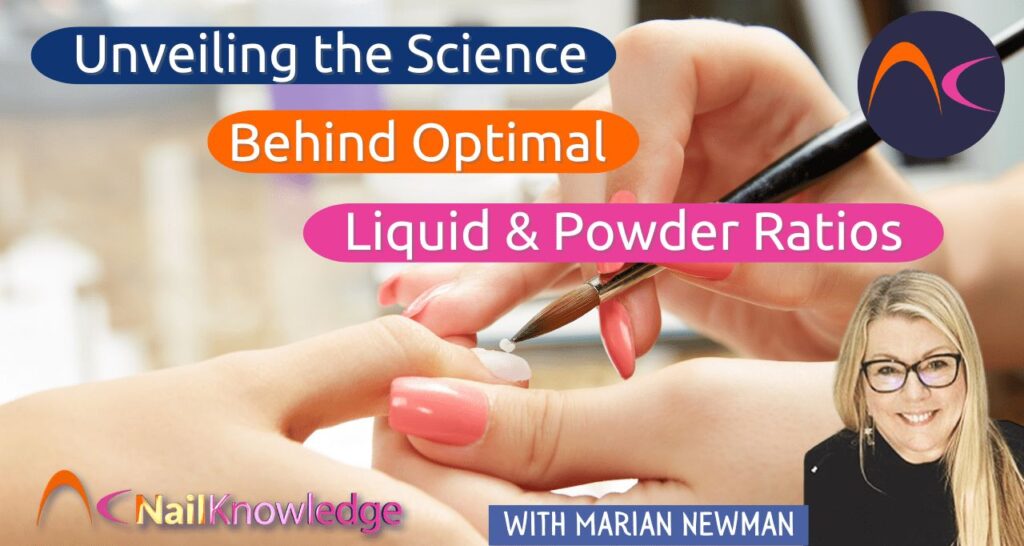Thinking about application skills and the critical role of liquid and powder ratios. The ratios hold the key to achieving nail perfection aesthetically and for longevity.
We explore how the ratios shape the essence of our craft from bead formation to mastering structure.
Monomer Concerns in UV-Cured Gels and L&P Applications
By now I hope most nail professionals are aware of the issues with high %’s of monomers in UV-cured gels. If there are so many they cannot all properly cure and some are left behind trapped in the solid coating and can leach out during wear.
The same applies to L&P. The monomer is the liquid and the powder is the polymer that also carries the initiator. The monomers need the initiator to start the polymerisation process but, instead of the UV energy that the UV-cured gels need, the energy comes from the heat of the finger and the temperature of the atmosphere.
If you use a ratio that is too wet, there is not enough initiator on the fewer polymer beads of the powder to start the monomers linking up to form the polymer. So, a lot of monomers are left behind trapped in the solid coating. Not only can these leach out but they create a coating that is not as strong as it should be and may result in breakages.
Perfecting the Craft: Mastering Bead Ratios
Getting the correct L&P ratio is down to practice and those new to the system or a new brand must spend some time practicing picking up beads. The bead should melt into a glossy sphere. It should not be so wet that it could drip off the brush or be too dry that the bead is an irregular shape. The most usual ratio is medium dry.
How you immerse your brush and how much you wipe on the side of the dapper list will depend on the size of the bead you need to pick up and this comes with practice.
How the loaded brush is dipped into the powder is another step that comes with practice. You should only dip the extreme tip of the brush into the powder. Some prefer to draw a line in the powder, while others just dip. Both are correct but the amount of powder to be picked up is the important aspect. A little nail does not need as big a bead as a thumb for instance. And the practice will result in knowing how much liquid needs to be in the brush and how long it is dipped into the powder.
A good practice is to decide what size of bead is needed and then pick up enough monomer and enough powder to form a glassy sphere. Place it on a sheet of plastic (that will not melt) and watch how it settles. In a very few seconds it should further melt into a glassy dome and not spread too much. If it is not glassy or an irregular shape it is too dry. If it spreads it is too wet. Keep practicing this until you can pick up a bead with the correct size and the correct ratio. Discard any bead that does not look right.
Some people like to ‘feed the bead’. This is when the widest part of the brush is pressed onto the bead which gives it more liquid. This will almost certainly create a too wet ratio. So will redipping the brush into the liquid once the bead is placed on the nail.
The best way to achieve the correct ratio is by the accurate liquid amount in the brush and accurate pick up of the powder. This also helps with the speed of application.
Manufacturer Expertise: The Crucial Role in Defining Optimal Ratio
Manufacturers should know what is the correct ratio for their products. There are some opaque coloured powders that need more than usual liquid and this should be taught in beginner or conversion education.
Crafting the Ideal Bead Shape: Defying Common Misconceptions
The videos that can be seen everywhere where the bead is applied to the nail and allowed to almost run down the length of the nail demonstrates a very wet bead that will leave a lot of uncured monomers in the coating. The bead should be manipulated into the correct shape by the brush as most of the liquid will have been used up by the polymer powder.
Again this comes with practice with the amount of pressure on the brush and the angle of the brush.
Conclusion
Something that looks so easy in skilled hands is actually a lot of careful practice and experience. It is not as easy as it looks and needs thought and practice. The structure is key with the apex perfectly positioned and a thin free edge and a blended edge at the base of the nail with no ridge to grow up and look unsightly
All of this will ensure you are providing the best service to your clients and coatings and enhancements that will look gorgeous and last 2-3 weeks before needing maintenance.
One more point to mention is that a good quality L&P, correctly applied and with a perfect structure, will break in an accident. This should happen before the natural nail breaks or is pulled off the nail bed. This seems to be happening a lot lately and is caused by too dry ration or too thick coatings. It is extremely painful and takes a very long time to heal.
For more in-depth insights on achieving perfect nails, don’t miss our comprehensive guide on Nail Brushes: Prep and Care. Learn how to keep your nail brushes in top shape for flawless results.


